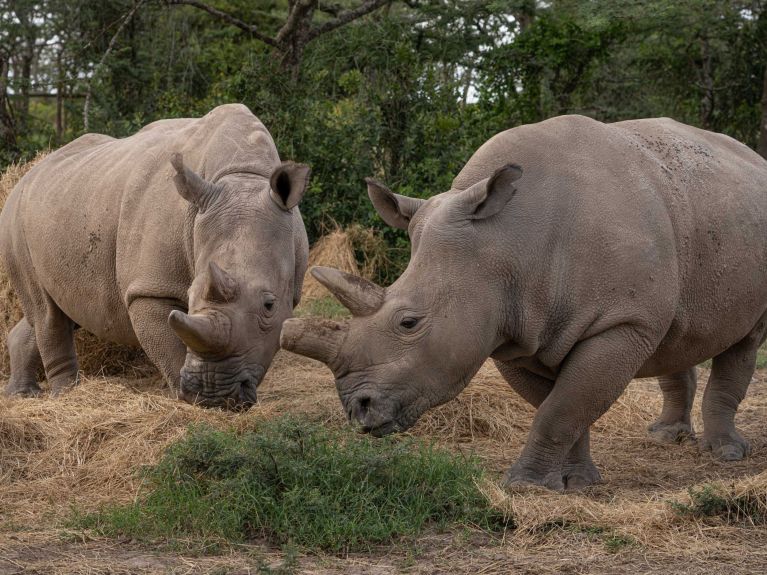Last chance for the white rhino?
There are only two northern white rhinos left – can the species be saved? The BioRescue project is trying to prevent its extinction.

There are only the two of them left in the world: Najin and Fatu are the last living northern white rhinos. Mother and daughter, aged 33 and 23, live under strict guard in the Ol Pejeta nature reserve in Kenya. They were both born in the Dvůr Králové Zoo in the Czech Republic – living in Kenya was something they first had to get used to. “When they came here they weren’t so familiar with certain things, of course. They didn’t know how to roll in mud puddles, deal with other rhinos or stand up for themselves,” Samuel Mutisya of the Ol Pejeta nature reserve tells Deutsche Welle. “But when we put them together with the southern white rhinos that live in the wild here, they adapted their behaviour.”
A catastrophe for species conservation: the last male died in 2018
The last male, Sudan, died in Ol Pejeta in 2018. Is that the end of the species? In the international consortium BioRescue run by the Leibniz Institute for Zoo and Wildlife Research in Berlin, researchers are trying to save the northern white rhino from extinction using advanced “methods of assisted reproduction and stem cell research”. This is necessary because during the lifetime of the last males, artificial insemination failed due to the poor quality of the semen. BioRescue, whose German partners are funded by the Federal Ministry of Education and Research (BMBF), is working on growing healthy embryos from natural stem cells (ART) and also artificial stem cells from cell culture (SCAT). The embryos are to be carried by surrogate mothers that are southern white rhinos. Some embryos are already available. But surrogacy will first be tested using the embryos of southern white rhinos before the final step is ventured towards species conservation using those of the northern white rhinoceros.
Dieses YouTube-Video kann in einem neuen Tab abgespielt werden
YouTube öffnenThird party content
We use YouTube to embed content that may collect data about your activity. Please review the details and accept the service to see this content.
Open consent formBiotechnical species conservation – ethical problems are taken into consideration
The biotechnical form of preservation involves numerous ethical problems, however. For example, there is the question of how far genetic engineering should be allowed to go. And: what risks and burdens can be expected of the last two living individuals in this process? BioRescue focuses very closely on these issues: after all, the idea is that the experience gained here should be put to use in the conservation of other species.

Najin and Fatu are shown a special fondness
And what about Najin and Fatu? Chief carer Zacharia Mutai has been looking after them for twelve years. He told Deutsche Welle: “I spend a lot of time with them, even more than with my own family. So I have a special connection with them.” He says mother and daughter appreciate a regular daily routine: “In the morning they’re very active, they eat and spend time with the other rhinos. Then when it gets too hot, they rest for six to seven hours and wait for it to cool down again.” Visits by the BioRescue scientists are now part of their routine.




